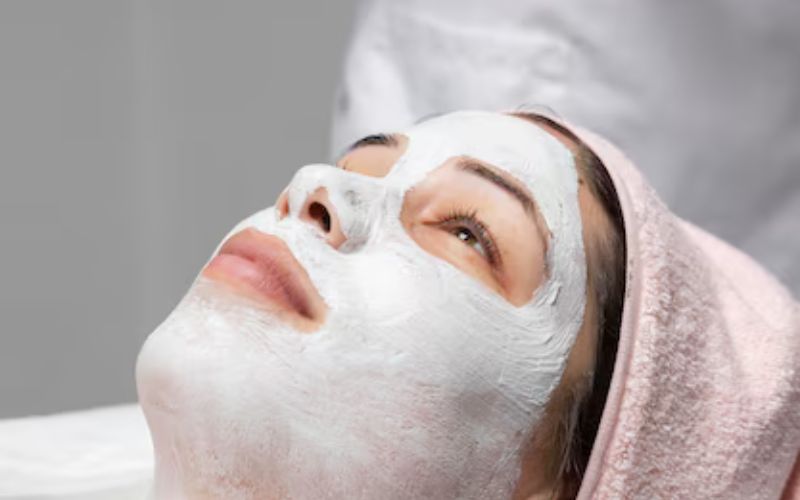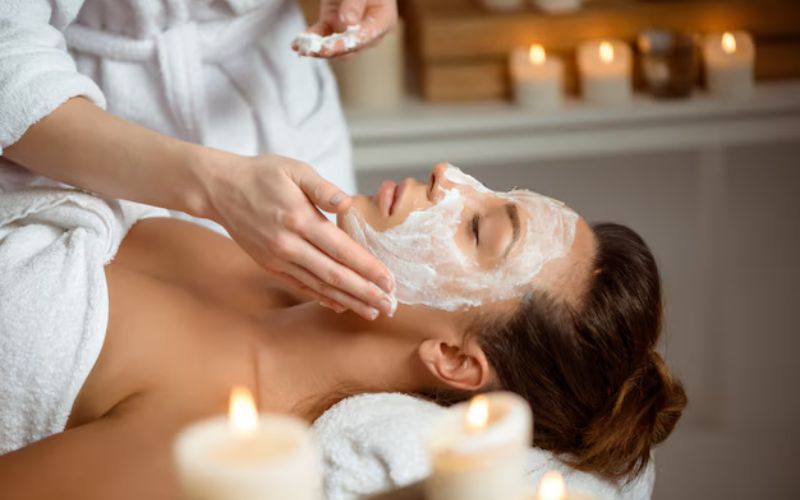Introduction
Chemical peels have become a popular and effective solution for rejuvenating the skin, addressing various skin concerns, and improving overall skin texture and tone. Whether you're dealing with acne scars, hyperpigmentation, or just looking to refresh your complexion, a face peel can offer significant results. In this comprehensive guide, we'll dive into the world of chemical peels, exploring the different types, their benefits, and what you can expect from each treatment. We'll also highlight the expertise of Dr. Vishal Brahmabhatt of KJ Aesthetics, a leading clinic that specializes in advanced skincare treatments, including TCA chemical peels.
What Are Chemical Peels?
Chemical peels are dermatological treatments that involve the application of a chemical solution to the skin, causing the top layers to exfoliate and eventually peel off. This process stimulates the growth of new skin cells, resulting in smoother, clearer, and more youthful-looking skin. Chemical peels, including TCA chemical peels, can be customized to suit different skin types and concerns, making them a versatile option for many patients.
Understanding the Different Types of Chemical Peels
Chemical peels are typically categorized based on their depth of penetration into the skin:
superficial, medium, and deep peels. Each type of face peel is designed to target specific skin issues and requires different levels of downtime and aftercare.
1. Superficial Peels
Superficial peels, also known as light peels, are the mildest form of chemical peels. They target the outermost layer of the skin, known as the epidermis, and are ideal for addressing minor skin issues such as:
Fine lines and wrinkles: Mild acne Uneven skin tone Dry or flaky skin Common Ingredients: Superficial peels often use alpha-hydroxy acids (AHAs) like glycolic acid or lactic acid, or beta-hydroxy acids (BHAs) like salicylic acid. These ingredients are effective in gently exfoliating the skin and promoting cell turnover without causing significant discomfort or downtime.
Procedure and Recovery: The procedure for a superficial face peel is relatively quick, usually taking about 15-30 minutes. The chemical solution is applied to the skin and left on for a few minutes before being neutralized and washed off. Patients may experience mild redness or peeling, but these effects typically subside within a few days.
2. Medium Peels
Medium peels penetrate deeper into the skin, reaching the middle layer of the dermis. These peels are more effective for treating moderate skin concerns, including:
Deeper wrinkles and fine lines
Sun damage and age spots Acne scars Hyperpigmentation Common Ingredients One of the most commonly used ingredients in medium peels is trichloroacetic acid (TCA), often referred to as a TCA chemical peel. TCA is a powerful agent that can provide more dramatic results than superficial peels, making it a popular choice for patients looking to address more significant skin issues.
Procedure and Recovery
Medium peels usually take longer than superficial peels, with the procedure lasting about 30-45 minutes. The chemical solution is applied in layers, and patients may feel a tingling or burning sensation as the solution works its way into the skin.
3. Deep Peels
Deep peels are the most intensive type of chemical peel, penetrating the deeper layers of the dermis. These peels are used to address severe skin concerns, such as:
Deep wrinkles and lines: Severe sun damage Pre-cancerous skin growths Pronounced scars Common Ingredients: Phenol is the primary ingredient used in deep peels. Due to its potency, phenol peels can produce dramatic results but also come with a higher risk of side effects and a longer recovery period.
Procedure and Recovery: The procedure for a deep face peel is more involved and often requires local anesthesia or sedation. The peel can take up to an hour, depending on the area being treated. Recovery from a deep peel is more extensive, with patients experiencing redness, swelling, and peeling that can last several weeks.
The Benefits of Chemical Peels
Chemical peels, including TCA chemical peels, offer a range of benefits for individuals looking to improve their skin's appearance and address specific concerns. Some of the key benefits include:
Improved Skin Texture: Chemical peels help to smooth the skin's surface, reducing the appearance of fine lines, wrinkles, and rough patches. Even
Skin Tone: Peels can lighten dark spots and hyperpigmentation, resulting in a more uniform complexion.
Acne Control: Chemical peels can help to unclog pores, reduce inflammation, and decrease the frequency of acne breakouts.
Collagen Production: By stimulating cell turnover and collagen production, chemical peels promote firmer, more youthful-looking skin. Non-Invasive: Chemical peels are a non-invasive option for skin rejuvenation, making them a popular choice for those who want to avoid surgery.

Is Chemical Peeling Good for Skin?
Yes, chemical peels, including TCA chemical peels, can be highly beneficial for the skin when performed correctly by a qualified professional. They offer numerous advantages, including:
Exfoliation: Chemical peels effectively exfoliate the skin, removing dead skin cells and revealing fresher, younger-looking skin underneath.
Improved Skin Texture: Peels can help smooth out rough or uneven skin texture, making the skin feel softer and look more radiant.
Reduction in Fine Lines and Wrinkles: Regular chemical peels can reduce the appearance of fine lines and wrinkles by promoting collagen production.
Treatment of Hyperpigmentation: Peels are effective in treating sun spots, age spots, and other forms of hyperpigmentation, leading to a more even skin tone.
Acne and Acne Scars: Certain types of chemical peels, particularly those containing salicylic acid or TCA chemical peels, can be very effective in treating active acne and reducing the appearance of acne scars.
What to Expect During a Chemical Peel Treatment
When you visit KJ Aesthetics for a chemical peel, you can expect a thorough consultation with Dr. Vishal Brahmabhatt. During this consultation, Dr. Brahmabhatt will assess your skin type, discuss your concerns, and recommend the most appropriate type of face peel for your needs. Before the Peel:
Pre-Treatment Care: Dr. Brahmabhatt may advise you to prepare your skin with specific skincare products in the weeks leading up to your peel. This can help to enhance the results and reduce the risk of complications.
Avoid Sun Exposure: It's important to avoid excessive sun exposure before your peel, as sun-damaged skin can be more sensitive to the chemical solution.
During the Peel: Application: The chemical solution will be applied to your skin using a brush or cotton applicator. Depending on the type of face peel, you may feel a tingling, stinging, or burning sensation.
Duration: The peel will be left on your skin for a specific amount of time before being neutralized or removed.
After the Peel: Immediate Aftercare: After the peel, your skin will need time to heal. Dr. Brahmabhatt will provide you with detailed aftercare instructions, including how to care for your skin and what to avoid during the recovery period.
Downtime: The amount of downtime will depend on the type of peel you receive. Superficial peels typically require little to no downtime, while medium and deep peels may require several days to weeks of recovery.
What to Expect During the Treatment

Choosing the Right Chemical Peel for You
With so many options available, it can be challenging to determine which chemical peel is right for you. Dr. Vishal Brahmabhatt at KJ Aesthetics will work closely with you to understand your skin concerns and goals, ensuring that you receive the most effective treatment. Factors to Consider:
Skin Type: Different skin types respond differently to chemical peels. Dr. Brahmabhatt will assess your skin to determine which type of face peel will provide the best results without causing irritation or adverse effects.
Skin Concerns: The severity and type of skin concerns you want to address will also influence the choice of peel. For example, if you have deep wrinkles or significant sun damage, a medium or deep peel may be more appropriate.
Recovery Time: Consider how much downtime you can accommodate in your schedule. If you need a quick treatment with minimal recovery, a superficial face peel may be the best option.
Desired Results: Your desired outcome will play a significant role in determining the type of peel. If you're looking for subtle improvements, a superficial peel may suffice. However, if you're aiming for more dramatic changes, a medium or deep peel may be necessary.
Chemical Peels at KJ Aesthetics: Why Choose Us?
At KJ Aesthetics, we are committed to providing our patients with the highest level of care and expertise in skincare treatments. Dr. Vishal Brahmabhatt brings years of experience and a deep understanding of dermatological procedures, ensuring that each patient receives personalized treatment tailored to their unique needs.
Why Choose KJ Aesthetics? Expertise: Dr. Brahmabhatt is a highly skilled professional with extensive experience in performing chemical peels, including TCA chemical peels, and other advanced skincare treatments.
Customized Treatments: We understand that every patient's skin is different. That's why we offer customized treatment plans designed to address your specific concerns and achieve your desired results.
State-of-the-Art Facility: Our clinic is equipped with the latest technology and tools to provide safe and effective treatments in a comfortable and welcoming environment.
Patient-Centered Care: At KJ Aesthetics, your satisfaction and well-being are our top priorities. We take the time to listen to your concerns, answer your questions, and ensure that you feel confident in your treatment choices.
Frequently Asked Questions (FAQ)
A face peel is a skincare treatment that removes dead skin cells from the outer layer of your skin, revealing smoother, brighter, and more youthful-looking skin underneath. It can be done using chemical solutions or natural exfoliants.
Yes, face peels come in various types, including chemical peels (like glycolic acid, salicylic acid, and lactic acid), enzyme peels, and physical exfoliants. The type of peel you choose depends on your skin type and desired results.
Yes, hair Botox is safe for colored or chemically treated hair. In fact, it can help repair damage caused by coloring, perming, or straightening by infusing the hair with essential nutrients and moisture. However, it’s advisable to consult with your stylist to determine the best timing for the treatment in relation to your coloring schedule.
Conclusion
Chemical peels, including TCA chemical peels, offer a powerful way to rejuvenate your skin, address a wide range of concerns, and achieve a smoother, more youthful complexion. Whether you're considering a superficial, medium, or deep face peel, the key to a successful outcome is choosing the right type of peel for your skin and working with an experienced professional like Dr. Vishal Brahmabhatt at KJ Aesthetics

